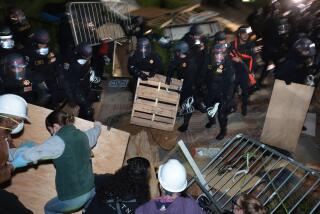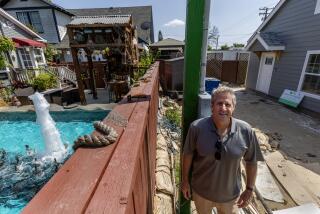L.A. Fire Department’s 1,577 Calls Rival Fourth of July
It was busier than the Fourth of July on Thursday at the Los Angeles Fire Department Operations Control Division four levels below the street at City Hall East.
In about five hours, between 7:42 a.m. when the earthquake struck and 12:30 p.m. when conditions began to return to normal, dispatchers took 1,577 calls, about as many as they normally receive during 24 hours on Independence Day, usually the firefighters’ busiest day.
Down the hall, the Emergency Operations Center--the “war room” where representatives of city, county and state agencies get together during a crisis--was activated at 8 a.m.
The city Fire Department responded to 464 calls for assistance in the five-hour period. Among other things, they took action on a fatality, 75 natural gas leaks, 46 heart attacks, 21 stalled elevators, 8 reports of downed electrical wires, 38 traffic accidents and 46 other injuries related to the quake.
Pleased With Services
Mayor Tom Bradley, Fire Chief Donald O. Manning and other city officials agreed that the damage from the quake could have been a lot worse, considering that the temblor measured 6.1 on the Richter scale. The mayor said he was “very, very pleased” with the way the city’s emergency services carried out their duties.
For the Fire Department, according to Battalion Chief Dean Cathey, the response began within moments of the shaking, initiated by a plan that directs firefighters at 105 stations throughout the city to move themselves and their equipment outdoors to predetermined safe locations and wait for calls. Minor damages were reported at three stations.
At about the same time, three Fire Department helicopters were dispatched to inspect reservoirs and dams, major hospitals, freeway interchanges, schools and major building complexes for signs of trouble.
Within about 35 minutes of the quake, according to Cathey’s estimate, the Fire Department’s three divisions had taken a tally of what units were available. Those that had not been dispatched then set out to assess damage and look for problems.
The city’s 54 paramedic and emergency ambulances answered dozens of calls for assistance that occurred at a rate twice the normal level. Eventually, according to Cathey, nearly 70 fire companies were called out, about half of the department’s total resources.
Firemen fought three major fires before noon: a two-room blaze at California State University, Los Angeles, where a woman student was killed by a falling slab of concrete from a parking structure wall; a church at 69th Street and Vermont Avenue, and a mini-mall on Western Avenue at 18th Street, where four shops were destroyed and a fifth damaged.
For the Los Angeles Police Department, the quake proved a manageable challenge, according to Dan Cooke, an LAPD spokesman.
Matter of Training
“We train for these kinds of emergencies several times a year,” Cooke said.
The LAPD declared a tactical alert, requiring 12-hour shifts. Officers on the morning watch, which ended about the time the quake struck, stayed on duty to reinforce the day shift. In some divisions, units of plainclothes officers put on uniforms and patrolled the streets.
Anti-looting units were sent to commercial areas. Five suspects were arrested in three incidents in the downtown area, where the quake shattered storefront windows, according to Cooke.
By early afternoon, several Police Department divisions began sending extra personnel home.
More to Read
Start your day right
Sign up for Essential California for news, features and recommendations from the L.A. Times and beyond in your inbox six days a week.
You may occasionally receive promotional content from the Los Angeles Times.






